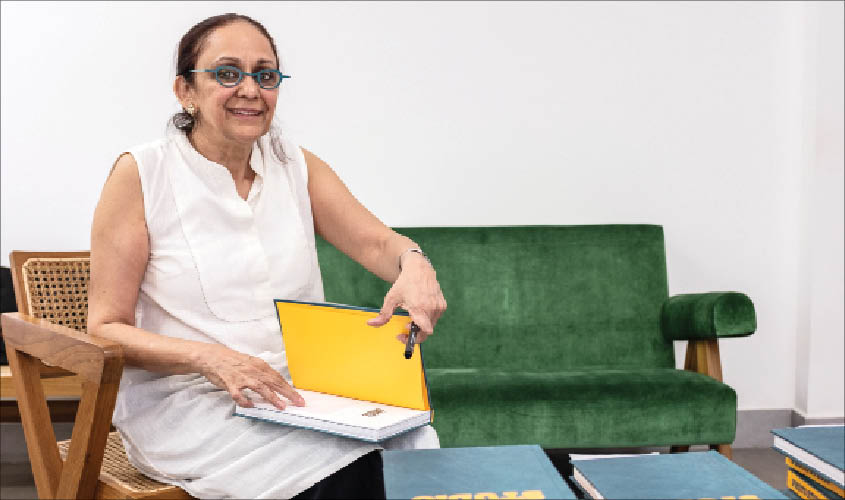Renowned photographer Ketaki Sheth travelled to eight states in the country in search of old photo studios that have now become relics of a bygone era. Her series of portraits clicked at these studios is part of an ongoing show in Delhi, writes Bhumika Popli.
In times when one is so content with selfies, the concept of visiting a photo studio for having that rare portrait clicked seems obsolete. Photographer Ketaki Sheth is aiming to revive the lost charm of such spaces through her solo show, entitled Photo Studio, now on view Delhi’s PHOTOINK gallery.
Looking at her 65 photos displayed at the show, it almost appears as though this is the work of some painter. Her photos resemble paintings, and many of her portraits—done against painted backdrops of hills, beaches and cityscapes—contain paintings within their frame.
But not all her photographs are portraits. Sheth’s photos of natural landscapes, compositionally strong, come across as vibrant colour studies. It’s surprising to find that Sheth only made black-and-white photos using the analogue medium, right from the beginning of her career, over three decades ago, until 2014.
“I didn’t look at a lot of colour photographs. Since childhood, I was surrounded by paintings as my mother had an eye for the arts. So I think that the sense of colour came easily to me. Before starting this work, I practised photography using a digital camera for one year,” says the photographer.

Her transition from analogue to digital was a carefully considered endeavour. According to her, she made this shift owing to a lack of skilled professionals in India who could assist her with the intricacies of analogue photography—like processing prints in a dark room.
In Sheth’s digital photographs we find an acute sense of the place. Her studio portraits are as much about the human subjects as about the setting. “The studios are alive in a dying sort of way,” says Sheth. “The real estate has really bloomed and I observed that most of the studios have downsized with computer-generated backdrops replacing the original ones.”
This series also includes pictures of props often found in old studios—props such as archaic light stands, box camera, a coat hanging in the studio and so on. Sheth got the idea to document the cultural heritage of photo studios after she saw an empty stool at the Jagdish Photo Studio, in her native Manori village of Maharashtra. This one glimpse, which became her first photo of the series, made her travel to eight states in the country, to document photo studios from 2015 to 2018.
Sheth has been photographing since the last 35 years and has always worked between street photography and portraits. The acclaimed Indian photographer Raghubir Singh was one of her mentors. “During classes, Singh used to ask me to show him not just the final photos but also the contact sheets. There were times when he was unhappy with my pictures, and would simply tear the contact sheets. That critique taught me a lot of things about the way to approach a photograph,” says Sheth.
Sheth was considered a master of portraits by her mentor, Singh. She says, “Raghubir Singh, after looking at my book of portraits, Twinspotting: Photographs of Patel Twins in Britain & India, had said, ‘You are good with portraits and this is your forte.’ And I think I would like to believe that statement.”
For her second book, entitled Bombay Mix: Street Photographs, Sheth busied herself with street scenes of Bombay. “My work for the Bombay book began way before I started working on Twinspotting, but Bombay Mix was published in 2007, after Twinspotting. I am an introvert and it was not easy for me to click London streets—I moved to London after marriage—the way I was doing it in India. Hence, the portraits happened,” says Sheth.

People take centre stage in her present series. And sometimes it was they who decided how they wanted to be photographed. “Many people were sceptical at first and asked me what I want to do with the photographs. I told them, ‘After the prints develop, first I’ll give you a copy.’”
This exhibition also marks the launch of the fourth photo book by Sheth. The title of the book is the same as that of the series. The book is designed by Itu Chaudhuri. In 1984, Sheth worked in a photo bookstore in New York which added to her knowledge of photography. “I wanted something connected with my practice and working in a photo bookstore was the right choice,” says Sheth.
Even in the age of selfies she manages to make good studio portraits. She says, “Often I have only five minutes with my subjects and sometimes I even get a good two hours. I have noticed that most Indians like to be photographed and now in the age of selfies, they have a sense of how they want to be photographed. But I always told my subjects to move away from the selfie style and they collaborated well.”
Sheth’s approach to portrait and street photography is similar. “You can’t plan for a portrait just as you can’t plan for a street picture. There is always an element of chance,” she says.
‘Photo Studio’ is on view at Delhi’s PHOTOINK gallery till 13 October

